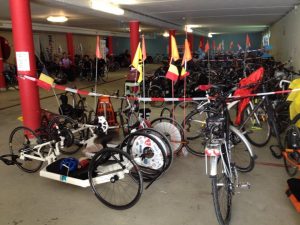Handbike
 All participants take their own hand bike to Austria. The team participants can ask for advice in the rehabilitation centre on the purchase, application or loan possibilities of a handbike. On www.handbiken.nl, you can post if you’re looking for a handbike or have one on offer.
All participants take their own hand bike to Austria. The team participants can ask for advice in the rehabilitation centre on the purchase, application or loan possibilities of a handbike. On www.handbiken.nl, you can post if you’re looking for a handbike or have one on offer.
Suitable handbike
A suitable handbike is a fixed handbike with sitting or lying position or a knee seaters. You need an extreme mountain resistance. It is useful to obtain information about this from a handbike specialty store.
For the participants with a torqueable E-bike to the wheelchair it becomes a challenge whether the front wheel is not slipping too much. The wheels of the wheelchair may need to be placed further back to prevent this.
It is possible to try on a treadmill (in the rehabilitation centres) whether the fixed-frame hand bike or wheelchair-E-bike combination is suitable for the hell rate of the Kaunertalergletscherstrasse.
Checklist handbike for HandbikeBattle (by Ralf Beekers)
- It is advisable to have travelled the necessary kilometres with your handbike before you start the HandbikeBattle. Don’t drive a handbike that you just have because this can lead to all sorts of inconveniences.
- The resistance must be at least 24/34 for men and 22/34 for women. The resistance is the ratio between the chain blade on the top and the chain blade at the wheel. In an ascent a small gear is needed, i.e. a small resistance. The chain is then placed on the smallest leaf at the top and the largest leaf at the wheel, those are the blades that are most on the inside. At the top it is wise to mount at least one leaf with 24 teeth and if it is possible a 22T leaf. The largest chain sheet on the cassette at the wheel will have to be at least 34 teeth. Check this or have it checked.
- The handbike must also be technically in order:
1. The gears must all be controlled. Try out if all chain wheels can be reached for the chain; definitely the smallest gear! If switching is tough or with a delay, we advise you to have the cables replaced.
2. The brakes must work well. Check the brake pads for wear and tear. Try the brakes well on an empty road. Operating the brake grip should be done with low pinch power. If this is not the case, we advise you to have the handbike checked. Also look at the brake pads: are they worn out, then replace them! If you’re not sure, leave it checked. Also check that the brake pads do not run into the tyre.
3. Arc cables from the handle to the frame should not have been nodded. The arc cables that run from the handle to the frame often break at the beginning and the end; in the places where they come from the control element (gear switch or brake grip) or at the frame. Check the cables for kinks. A nodded or torn cable is often an indication that the cable will break pretty quickly.
4. The wheels must be straight and do not run. Check the wheels for strokes and whether the brakes do not run into the rim. Also look at the rear wheels and have the wheels focused if necessary.
5. The tyre pressure must be sufficient. Pump the tires regularly. The handbike drives through it a lot lighter and the tires wear less hard.


